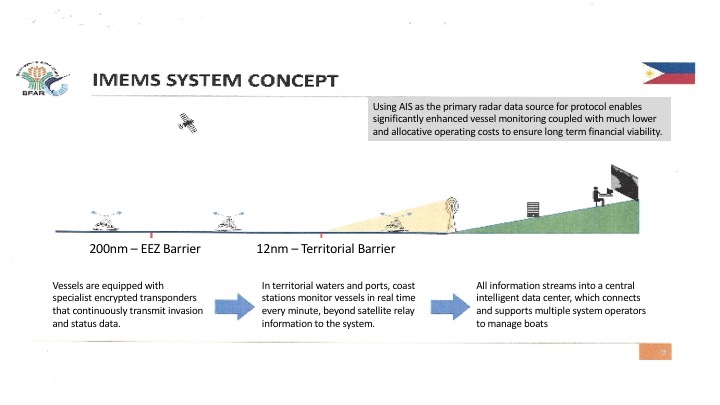To further intensify the campaign against illegal, unreported, and unregulated fishing (IUUF), the Department of Agriculture – Bureau of Fisheries and Aquatic Resources (DA-BFAR) is now implementing the Integrated Marine Environment Monitoring System (IMEMS) Project, an innovative, optimized, and integrated monitoring system that expands and improves the Bureau’s current monitoring, control, and surveillance (MCS) program.
The new MCS technology seeks to harness Information and Communications Technology (ICT)-enabled advisory services and vessel monitoring system to effectively connect farmer and fishers in the regional and global agricultural value chain.
With the IMEMS, the Bureau can now track and communicate with Philippine-flagged fishing vessels in real time on a national scale, integrating communication, licensing, and law enforcement functionalities to ensure compliance with various conservation and management measures being implemented in the Philippine waters, Exclusive Economic Zone (EEZ), and in other Coastal States.
The IMEMS Project is now being implemented nationwide following the enactment of Fisheries Administrative Order (FAO) 266, or the Rules and Regulations on the Implementation of Vessel Monitoring Measures (VMM) and Electronic Reporting System (ERS) for Commercial Philippine Flagged Fishing Vessels Amending FAO 260 Series of 2018 that requires the installation of VMS-100 transceivers in all commercial fishing vessels with more than 3.1 gross tonnage, operating domestic waters, in the High Seas, and other distant waters.
KEY CONCEPTS OF IMEMS PROJECT
Unlike earlier technology of vessel monitoring, the IMEMS Project now integrates three functionalities for vessel monitoring system namely; communication, licensing, and law enforcement to ensure that all activities of commercial fishing vessels are closely monitored in real time.
Using a low-cost technology that combines terrestrial and satellite monitoring sensors to increase vessel tracking capacity and capability, the IMEMS project conducts continuous and automatic mass data collection and operates advance data analytics accessible to DA-BFAR partners.
The single data set collected from the system can be used by DA-BFAR operators across the country in their monitoring efforts, complimenting existing IUUF efforts of LGUs and DA-BFAR Fisheries Resource Protection Group (FRPG). To further capacitate law enforcers, the system employs advanced digital display technologies with integrated communication tools that can help increase situational awareness and engagement of designated DA-BFAR data operators with what is happening on the ground. This increases the effectiveness of law enforcement.
Because of its integrated monitoring system, real time data collection for quick response and scientific research is now possible with IMEMS. It allows fisheries law enforcers to detect IUUF in real time and for scientists to collect relevant oceanographic, meteorological, and fish catch data that can be used for quick response, disaster recovery, scientific research, and climate change mitigation measures.
To ensure data privacy, the IMEMS uses a low-cost encrypted Automatic Identification System (AIS) communications technology, certified by the International Maritime Organization, for its vessel data transmission.
HOW IT WORKS
The IMEMS Project requires first, an installation of a VMS-100 Fisheries Monitoring Transceiver, a vessel tracking device usually deployed in large scale fisheries monitoring that uses a low-cost high intelligence dual satellite and terrestrial communication system.
Aside from the installation of a VMS-100 transceiver, an intelligent vessel ID plate with embedded Radio Frequency Identification (RFID) that is transmitted to the IMEMS system via fisherfolk’s mobile phones and port ERS.
To track vessels in real time, the Bureau is now currently building around 132 coastal sensors and regional control centers to monitor commercial fishing vessels with VMS-100 transponders within the 100 nautical mile boundary from each site.
These regional sites will feed real time data to the Bureau’s National Data Center in Navotas, now operational since March 2020. The National Data Center will be in-charge of data processing and analytics, including integrated vessel tracking, license management, ELOG and automated detection of IUU activities of these vessels.
CURRENT IMPLEMENTATION
Philippine-flagged commercial fishing vessels are currently being installed with Vessel Monitoring System transceivers (VMS-100), in compliance with FAO 266. Many are commercial fishing vessels deployed in domestic waters, while some operate in the High Seas Pocket 1 (HSP1) of the Western and Central Pacific area. DA-BFAR’s floating assets are also being installed with VMS-100.
The Bureau targets to install around 5,000 Vessel Monitoring Systems in commercial fishing vessels by the end of 2021. With the IMEMS Project, the Bureau hopes to further strengthen its fisheries conservation and management measures that will pave the way towards a more food secure and resilient fisheries industry.
